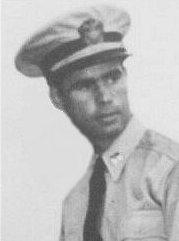
Rear
Admiral Roger Warde Paine, Jr.
August 13, 1917 - November 16, 2008
Roger
Warde Paine, Jr. was born in Austin, Texas on August
13, 1917, son of Rear Admiral Roger W. Paine, USN
and Mrs. Corine (Malone) Paine. He attended
Western High School, Washington, D.C. and Coronado
(California) High School prior to entering the U.S.
Naval Academy on appointment from the District of
Columbia in 1935. He was graduated and commissioned
Ensign on June 1, 1939.
Following graduation he joined the USS ARIZONA and
in December 1940 was detached from that battleship
for submarine training at the Submarine Base, New
London, Connecticut. In April 1941 he reported
on board the USS POMPANO and was serving in that
submarine when the United States entered World War
II on December 8, 1941. For meritorious conduct
as Communication, Radar and Sound Officer of the
USS POMPANO during her First War Patrol he was awarded
the Navy Commendation Medal with Combat "V".
From
March 1942 to August 1943 he continued duty afloat
in the USS WAHOO rising to Executive Officer and
Navigator. Prior to embarking on WAHOO's Fifth
War Patrol, Lieutenant Paine underwent emergency
surgery for appendicitis. He was subsequently
given command of the USS S-34. In August 1944
he became Executive Officer and Navigator of the
USS TINOSA. Participating in eight successful
war patrols in the Pacific during World War II,
he was awarded the Silver Star Medal, the Bronze
Star Medal with Combat "V", and a Gold Star in lieu
of a Second Bronze Star medal, also with Combat
"V". He is also entitled to the Ribbon for,
and a facsimile of, the Presidential Unit Citation
awarded the USS WAHOO.
In
May 1945 he reported for fitting out duty in the
USS CUBERA at the Electric Boat Company, Groton,
Connecticut and assumed command of that submarine
upon her commissioning, December 12, 1945.
Detached from the CUBERA in April 1945, he briefly
commanded the USS WHALE which was decommissioned
at New London, Connecticut on June 1, 1946.
He
next reported for instruction in Ordinance Engineering
(Special Physics Course) at the Postgraduate School,
Annapolis, Maryland. From June 1947 to February
1949 he continued the course at the Massachusetts
Institute of Technology at Cambridge from which
he received the degree of Master of Science in Nuclear
Physics. He next was engaged in field work
at various ordinance facilities and during the period
of August 1949 to August 1951 he worked at the Los
Alamos (New Mexico) Scientific Laboratory doing
design and development work on the nuclear components
of atomic bombs and of the H-bomb, which was in
the design stage at that time.
From
August 1951 to September 1953 he commanded the USS
COWELL which, under his command, made an around-the-world
cruise and spent five months in the Korean War theater.
In September 1953 he reported as Chief of the Analysis
Branch, Armed Forces Special Weapons Project, Washington,
D.C. In that capacity he participated in all
nuclear weapon tests during 1954 - 1956, both in
Nevada and at Eniwetok and Bikini, and supervised
analysis and correlation of the data obtained.
Ordered
to the Naval War College, Newport, Rhode Island
he had instruction there in Naval Warfare from August
1956 until June 1957 and became Commander, Destroyer
Division TWO HUNDRED EIGHTY-TWO in July of that
year. This Division, consisting of the USS
EATON, BACHE, BEALE and MURRAY, participated in
NATO maneuvers in Europe in the fall of 1957 and
later formed a part of Anti-Submarine Group ALFA,
a special group formed to develop and perfect operational
techniques of anti-submarine warfare.
Assigned
in November 1958 to the Bureau of Ordinance, Navy
Department, Washington, D.C., he headed the Guided
Missile Branch, Research Division until 1959, when
that Bureau and the Bureau of Aeronautics were combined
and designated the Bureau of Naval Weapons.
He then became Director of the Missile Guidance
and Airframe Division and as such was responsible
for research, development, test and evaluation of
the Navy's BULLPUP, CORVUS, EAGLE, SIDEWINDER, SPARROW,
TALOS, TARTAR, TERRIER and TYPHON missiles.
In
September 1961 he assumed command of the USS TOPEKA
in the Pacific area and commanded her during anti-air
warfare operations off the California coast and
in Hawaiian and Far Eastern waters. Returning
to Washington, D.C. in November 1962, he served
as Head of the Surface Warfare Branch, Office of
the Chief of Naval Operations, Navy Department,
until June, 1963. He then reported as Military
Assistant to the Deputy Director of Defense Research
and Engineering (Administration and Management),
Office of the Secretary of Defense, Washington,
D.C. He was awarded the Joint Service Commendation
Medal for his work in this position.
In
the fall of 1966 he was promoted to Rear Admiral
and in December became Commander, Cruiser-Destroyer
Flotilla TEN, a unit of the U.S. Atlantic Fleet
consisting of twenty-one cruisers and destroyers.
In the Spring of 1967 he deployed to the Mediterranean
as Commander of an Attack Carrier Strike Group,
flying his flag alternately in the aircraft carriers
USS SHANGRI-LA and SARATOGA and in the guided missile
cruiser USS GALVESTON.
He
reported in January 1968 as Director of the Navy
Information Systems Division, Office of the Chief
of Naval Operations with the responsibility for
the procurement, maintenance and operation of all
of the Navy's computers. In August 1970 he
was ordered detached for duty as Commander, Training
Command, U.S. Pacific Fleet with Fleet Training
Activities in Japan, Guam, Hawaii, San Diego, Long
Beach and San Francisco. He was awarded the
Legion of Merit in connection with this duty and
retired from naval service in the summer of 1972.
Admiral
Paine was married to the former Isla Rea
Vaile for over fifty years, had three children,
numerous grandchildren and great grandchildren.